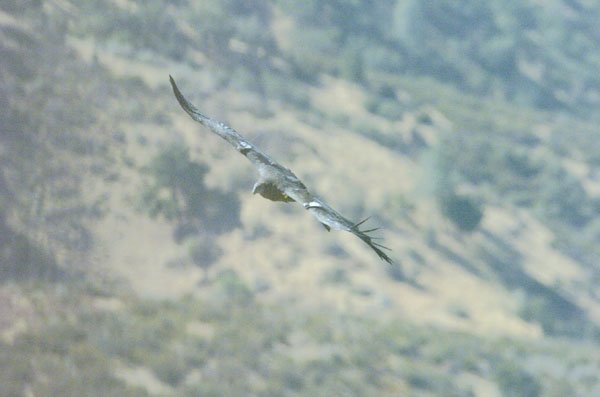Six-year-old Kate Chandler was so excited about getting another
chance to see the endangered California Condor that she sprinted
down the path to the viewing area at Pinnacles National Monument
Saturday morning.
Hollister – Six-year-old Kate Chandler was so excited about getting another chance to see the endangered California Condor that she sprinted down the path to the viewing area at Pinnacles National Monument Saturday morning.
Chandler, who dressed up as a condor for Halloween last year, has a love for North America’s largest bird that is matched by few.
She and more than 100 others from across the state made the 1.5 mile hike to a viewing area in the Pinnacles to witness the release of three majestic California Condors into the wild on Saturday.
The birds, which came to the park from breeding facilities at zoos in Southern California and Oregon, were released from their flight pen through a double-door trap in order to minimize their contact with humans, Park Biologist Jim Petterson said.
Once all three of the male condors were in the double-door trap, the door to the outside was opened.
For several minutes all three of the birds hopped around on the trap door perch. Then condor 330 (named after his tag number) wowed the crowd by flying free for the first time ever, eventually landing nearby to perch on the ground.
The other two birds, condor 332 and 340 soon followed, flapping their wings in free flight. The crowd responded with applause and cheers.
The scheduled release was the third in the park’s continuing efforts to re-introduce the once nearly-extinct bird to the wild. So far park biologists have released nine condors, six last year and three this year. The birds are born in breeding facilities and then transferred to the park, where they are reared by a mature adult mentor. The adult mentor, named Hoinewut, teaches the juvenile birds skills that they will need to live outside the flight pen.
Now that the birds have been released into the wild, park rangers will re-double their efforts to make sure the birds find safe food and perch in trees instead of on the ground or near power lines. Birds that fail to establish healthy habits may be re-captured.
“Our goal is to have about 150 (condors) in California,” Ventana Wilderness Society Executive Director Kelly Sorenson said. “Right now, we’re about a third of the way there.”
Ventana Wilderness Society, a private non-profit organization dedicated to re-populating Big Sur with California Condors, teamed up with the National Park Service in 2003 to help release the birds in Pinnacles National Park and in the Ventana Wilderness Area.
Saturday’s release was a big step for the overall condor recovery effort, park officials said. As a result of the combined efforts of several condor recovery efforts in California, Oregon, Arizona and Baja California, the number of free-flying condors have increased dramatically since 1984, when only 22 of the birds remained in the wild. By 1987 all of the birds were taken into captivity.
Petterson said that 153 condors are in captivity today in several different states.
Pinnacles National Park is home to nine of the 57 wild condors in California. The three condors released Saturday will join six others released last year, Petterson said. The overall goal is to make the park home to about 30 condors.
But the work for park rangers is far from over once the birds are released – one of the reasons only three of the seven condors the park has in captivity were released.
Park rangers will track the birds using a GPS system to ensure the condors develop appropriate feeding and perching behaviors.
Rangers will steer the birds away from people and help them to establish safe and healthy habits in the wild.
“If they don’t find a good, safe perch, we’ll have to chase them into one,” Petterson said.
And the work of caring for the birds began Saturday. According to the park’s Web site, condor 330 took a short flight in the late afternoon and landed downhill from the flight pen. He then ended up roosting on the ground because there were not any trees nearby. Biologists spent the night nearby to flush away coyotes and other predators.
For more information about the release, go to www.nps.gov/pinn/condor/release.htm
By Brett Rowland















